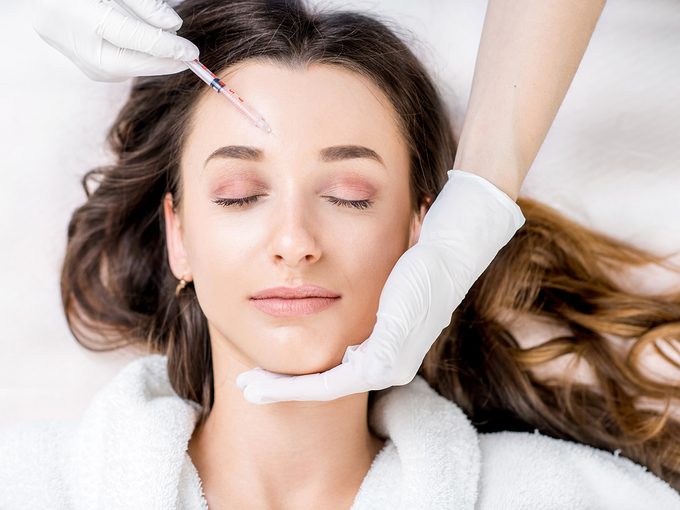What You Need to Know About Botox
Find out if Botox is safe, and what you need to know before getting it.

Wondering what kind of slippery slope that Botox before and after presents?
Will your face start to sag if it’s not regularly injected? I’ve wondered about that — typically while watching TV and noting which star has gone nuts with the needle — and I am a holdout. Yet as I’ve seen Botox’s good effects on friends and peers, I’m thinking: Never say never.
Year after year, Botox ranks as the number one minimally invasive cosmetic procedure, according to the American Society of Plastic Surgeons (which represents Canada’s Royal College of Physicians and Surgeons). In 2009, 4.8 million Botox cosmetic procedures were done in the U.S. That’s down four per cent from 2008, but still ahead of hyaluronic acid dermal fillers (such as Juvéderm and Restylane, which showed a seven per cent upswing). Botox also topped non-surgical procedures globally in survey results released in August by the International Society of Aesthetic Plastic Surgery.
Try making these plastic surgeon–approved anti-aging masks at home!
What is it?
It’s a poison: a purified protein called botulinum toxin type A derived from bacteria. It temporarily relaxes muscle areas by blocking nerve impulses that trigger contractions, softening wrinkles and modifying expression. In therapeutic treatment it’s used for cerebral palsy and conditions such as excessive sweating. Although Botox has been used off-label since the 1990s in North America, Health Canada only approved it in 2001 for treating the two vertical lines between the brows (the ‘elevens’) and in 2005 for forehead wrinkles and crow’s feet.
A study published in 2009 in the Journal of Cosmetic Dermatology found that Botox may also improve a person’s mood. The theory there? The less you scowl — a facial expression that’s not easy to make with a smoothed brow — the more upbeat you feel. People who like it (some of my friends included) say it’s simply one item on the menu of ways to stay youthful looking, especially in a competitive workforce.
But if you try it and then decide to stop, what happens? “There’s this myth that if you stop using Botox, your face will look wrinkly and your features will cascade into a degenerative state you never had,” says Toronto cosmetic surgeon Dr. Stephen Mulholland, whose average Botox patient is age 40. But in fact, he says, if you stop, your face returns to its normal animation, and facial muscles return to normal strength. (Of course, you have aged slightly since you were injected, which may be apparent when it wears off.)
Another fear, Mulholland acknowledges, is that your face will be erased of expression. “Patients say they don’t want to look like they have had too much Botox.” (He speculates Nicole Kidman has had too much.) “It isn’t about removing every facial expression; it’s to temporarily modify expressions so you don’t look angry, sad or tired.”
Considering injectible fillers for volume, too? Here’s what you need to know.
What about the risks of Botox before and after?
Common side effects are bruising and swelling. Rarely, there is “serum sickness,” which manifests as flu-like symptoms that subside in a few hours, says Mulholland. “A dreaded complication is that the Botox travels through fatty tissues to muscles it wasn’t intended to block — like a muscle of the eyelid, which leads to ptosis (droopy eye), or the muscles that move the eyeball, leading to double vision.” He says these happen to less than one per cent of patients and go away within two weeks. The Botox Cosmetic website states asthma symptoms and inability to swallow have also been reported.
Another risk? “Some people get horribly addicted to looking three to five years younger. That’s expensive,” says Mulholland. Patients pay an average of $12 a unit, and it could take 30 units just to treat frown lines; that’s $400 to $600 a visit. On average, people get it two or three times a year. Cha-ching.
If you’re interested, talk to your physician about getting a referral. (If I were to go for it, I’d also do my own research, maybe asking a friend who’d had a positive experience — and whose results I could see — for the name of her doctor.) Then check with your provincial college of physicians for disciplinary issues, the Canadian Medical Protective Association for malpractice issues and RateMDs.com to see what other patients say about specific doctors. Ask for Botox before and after photos, and get a sense of how long the doctor has been administering Botox. (Are are a few other questions to ask your doctor before taking the plunge.)
This article was originally titled “Help me, Rhonda!” in the October 2010 issue of Best Health. Subscribe today to get the full Best Health experience — and never miss an issue!




